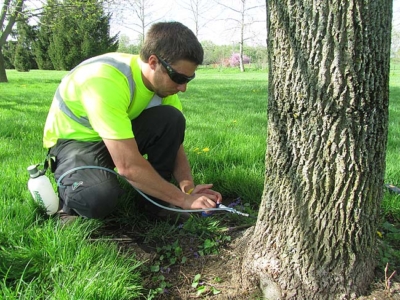PBL training center debuts in Yellow Springs schools
- Published: May 26, 2016
Interest from other school districts in project-based learning, or PBL, has increased significantly, according to Yellow Springs District Superintendent Mario Basora.
“It’s exploded this year,” Basora said in an interview last week.
The Yellow Springs district stands to gain from that growing interest. In its fourth year after transitioning from a district using a traditional educational model to a focus on the hands-on, collaborative model of project-based learning, the district aspires to become a PBL training center. At the May 12 school board meeting, the goal of creating a training center became reality, with unanimous board approval of the YS Deeper Learning Training Center.
The new training center builds on what’s already taking place in Yellow Springs schools. About 120 teachers and administrators from other districts have visited local schools to learn about PBL in the past three years, according to Basora, and more trainings are scheduled for the summer and fall.
In general, the visiting educators leave impressed with what’s happening at Yellow Springs schools.
“What we’re hearing is that it’s one thing to hear about PBL theoretically, and another thing to see it,” Yellow Springs High School Principal Tim Krier said, regarding visitors. “They’re amazed. They leave here enthused and inspired.”
Just last week, visiting educators included teachers and administrators from West Milton Union schools and from the Central Educational Services Center in Columbus, which offers professional training to -teachers.
“I was extremely impressed by the level of commitment from all the staff and students,” said Mindy Farry, a trainer at the Educational Services Center of Central Ohio, in an email. “Yellow Springs is a perfect example of a school doing PBL that fits their academic areas, their students and their community.”
Ambitious goal
Becoming a PBL training center was part of the 2020 vision for local schools adopted by the district several years ago. But at the time, Superintendent Basora worried that perhaps it was wishful thinking to expect other districts to clamor for training for a little known educational model.
“At the time it seemed far-fetched and a long ways off,” he said last week. “It was extremely ambitious.”
But interest in PBL has grown rapidly since then. Ten groups visited the local schools this year, and in June Yellow Springs teachers will train teachers from the Finneytown and St. Bernard schools in Cincinnati, followed by training for the education staff at Antioch University Midwest. Other training partnerships are also in the works, Basora said. While Yellow Springs educators had to travel to High Tech High in California to learn about PBL, Ohio schools now have a closer and less expensive training option in Yellow Springs.
The local district is ahead of other Ohio schools in PBL expertise because it’s maintained a clear focus on PBL for the past four years, a singular vision that differs from that of many other districts, according to Basora.
“So often in school districts, you go from one initiative to another, and it’s just too much,” he said. “We’ve been consistent.”
Yellow Springs schools have also become a destination for training partly because it’s the only district that uses PBL in kindergarten through high school, rather than just middle school and high school, according to Mills Lawn teacher Heidi Hoover, who serves as a PBL coach to other MLS teachers. And while that means lower-grade elementary school teachers have few models for adopting PBL for their students, it also offers opportunities for creativity.
“It’s an added challenge but also has more possibilities,” she said.
But mainly, Basora believes, teachers and administrators from other districts have grown excited about PBL when they witness local students’ and teachers’ passion and enthusiasm for their projects. That passion is in marked contrast to the past 15 years’ national focus on standardized testing, a focus on teaching to the test that critics believe has led to less creativity and innovation in the classroom.
“We go into this profession to make a difference, to ignite a love of learning, to make the world a better place,” Basora said, and he believes the visiting educators see in PBL projects these qualities.
For instance, last week’s PBL exhibition night included various YSHS sophomore projects driven by the question, “Is it too late to save the planet?” Sophomores took on the challenge of creating sustainable ways of living, with projects that included the building of a working windmill from scratch, the creation of circular compost bins and the housing of a beehive with 10,000 bees (outside) in an effort to increase pollination in Yellow Springs.
Other recent PBL projects included a Mills Lawn fourth-grade effort to envision and design a new school building, a second-grade project that aims to increase empathy, and a first-grade study of insects.
Local school leaders believe that visiting educators not only see students’ enthusiasm for their work, but a depth of critical thinking and understanding that goes beyond expectations, according to Principal Matt Housh from Mills Lawn.
“I often hear visiting teachers say, wow, I can’t believe those are first-graders, or third-graders, or whatever grade it is presenting the project,” he said.
Fair compensation for teachers
The proposal for the PBL training center approved by the board last week included a cost structure for trainers and customers. According to the plan, visiting school districts will be charged $50 per person per day for training, $60 per hour for mobile coaching, and $700 per day per trainer if off-site.
Also, Yellow Springs teachers who serve as trainers will be paid $40 per hour for three hours of training prep time for a half-day seminar, $125 per day for presenting a seminar on non-contract days and $350 per day for creating an original curriculum, a sum that can be divided by a number of teachers.
The aim, according to Basora, is that about half of the PBL training income will go to teachers and half into a PBL fund.
“We want to create a new source of revenue and also compensate teachers fairly,” he said.
The compensation structure reflects the need to recognize the effort of Yellow Springs teachers, who had to create a new curriculum and new ways of teaching, and are the single biggest reason for the program’s success, Basora said.
“It takes a lot of work up front,” he said. “The teachers are working tremendously hard.”
The Yellow Springs News encourages respectful discussion of this article.
You must login to post a comment.
Don't have a login? Register for a free YSNews.com account.
Parkinsons.jpg)














No comments yet for this article.